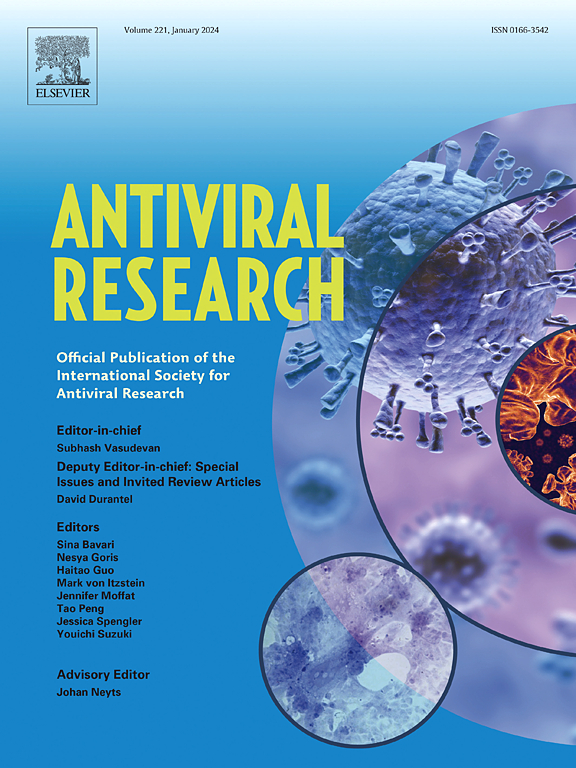Marburg and Kasokero viruses elicit differential antiviral innate immune control by their natural reservoir bat, the Egyptian rousette (Rousettus aegyptiacus)
IF 4
2区 医学
Q1 PHARMACOLOGY & PHARMACY
引用次数: 0
Abstract
To investigate the antiviral innate immune responses of natural reservoir bats, we conducted a histopathological analysis of Egyptian rousettes (Rousettus aegyptiacus) experimentally infected with either of two divergent RNA viruses they naturally host, Marburg virus (MARV; family Filoviridae) and Kasokero virus (KASV; family Nairoviridae). Bats were serially euthanized at similar post-infection time points and tissue-based analyses focused on the liver, the primary target for both viruses. At 3 days post-infection (DPI), in situ hybridization (ISH) signal for replicating MARV was 300x less evident than that of KASV, with little immune cell recruitment and localized interferon (IFN)-stimulated responses suggesting a tendency towards superb virus replication control and non-cytolytic viral clearance. By comparison, an early burst of hepatocellular KASV replication correlated with robust, tissue-wide IFN-stimulated responses, mononuclear phagocyte apoptosis, targeted natural killer (NK) and/or natural killer T (NKT) cell responses and localized cytokine induction, demonstrating the capacity to swiftly establish an antiviral state. The distinctive lack of IFN stimulated gene 15 and MARV RNA hepatocellular co-localization in a single MARV-infected bat with overt hepatitis suggests a fine-tuned role for IFN antagonism in Egyptian rousettes, and hints at how MARV-IFN pathway interactions might influence the evolution, transmission and maintenance of orthomarburgviruses in nature, whereas KASV is less adaptable to this vertebrate host. This work augments our understanding of bat immunology and suggests certain co-evolutionary relationships between bats and viruses. These defenses may be more broadly applicable to other viruses circulating in Egyptian rousettes and likely to other bat-virus relationships.
马尔堡病毒和卡索克罗病毒通过它们的天然宿主蝙蝠——埃及玫瑰蝠(Rousettus aegyptiacus),引起不同的抗病毒先天免疫控制。
为了研究天然储蝙蝠的抗病毒先天免疫反应,我们对埃及Rousettus aegyptiacus进行了组织病理学分析,实验感染了它们天然宿主的两种不同RNA病毒:马尔堡病毒(MARV);丝状病毒科)和卡索克罗病毒(KASV;家庭Nairoviridae)。在相似的感染后时间点对蝙蝠进行了连续安乐死,并对肝脏进行了基于组织的分析,肝脏是两种病毒的主要目标。在感染后3天(DPI),复制MARV的原位杂交(ISH)信号比KASV的信号弱300倍,免疫细胞募集很少,局部干扰素(IFN)刺激的反应表明有极好的病毒复制控制和非溶细胞病毒清除的趋势。相比之下,肝细胞KASV复制的早期爆发与强大的、组织范围内的ifn刺激反应、单核吞噬细胞凋亡、靶向自然杀伤(NK)和/或自然杀伤T (NKT)细胞反应和局部细胞因子诱导相关,显示出迅速建立抗病毒状态的能力。在一只携带明显肝炎的单一MARV感染的蝙蝠中,IFN刺激基因15和MARV RNA肝细胞共定位的明显缺失表明,IFN拮抗剂在埃及rousettes中发挥了微妙的作用,并提示MARV-IFN途径的相互作用如何影响自然界中正马尔堡病毒的进化、传播和维持,而KASV对这种脊椎动物宿主的适应性较低。这项工作增加了我们对蝙蝠免疫学的理解,并表明蝙蝠和病毒之间存在某些共同进化关系。这些防御措施可能更广泛地适用于在埃及rousettes中传播的其他病毒,也可能适用于其他蝙蝠-病毒关系。
本文章由计算机程序翻译,如有差异,请以英文原文为准。
求助全文
约1分钟内获得全文
求助全文
来源期刊

Antiviral research
医学-病毒学
CiteScore
17.10
自引率
3.90%
发文量
157
审稿时长
34 days
期刊介绍:
Antiviral Research is a journal that focuses on various aspects of controlling viral infections in both humans and animals. It is a platform for publishing research reports, short communications, review articles, and commentaries. The journal covers a wide range of topics including antiviral drugs, antibodies, and host-response modifiers. These topics encompass their synthesis, in vitro and in vivo testing, as well as mechanisms of action. Additionally, the journal also publishes studies on the development of new or improved vaccines against viral infections in humans. It delves into assessing the safety of drugs and vaccines, tracking the evolution of drug or vaccine-resistant viruses, and developing effective countermeasures. Another area of interest includes the identification and validation of new drug targets. The journal further explores laboratory animal models of viral diseases, investigates the pathogenesis of viral diseases, and examines the mechanisms by which viruses avoid host immune responses.
 求助内容:
求助内容: 应助结果提醒方式:
应助结果提醒方式:


